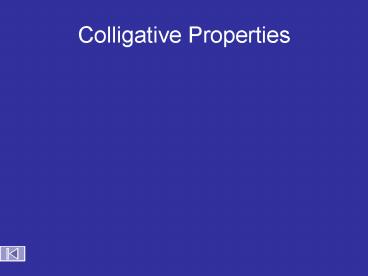Colligative Properties - PowerPoint PPT Presentation
1 / 11
Title:
Colligative Properties
Description:
Colligative Properties. occurs when neutral ... electrolytes: solutes that dissociate in solution ... nonelectrolytes: solutes that DO NOT dissociate ... – PowerPoint PPT presentation
Number of Views:1243
Avg rating:3.0/5.0
Title: Colligative Properties
1
Colligative Properties
2
occurs when neutral combinations of particles
separate into ions while in aqueous solution.
Dissociation
NaCl ? Na1 Cl1
sodium chloride
sodium hydroxide
NaOH ? Na1 OH1
hydrochloric acid
HCl ? H1 Cl1
sulfuric acid
H2SO4 ? 2 H1 SO42
CH3COOH ? CH3COO1 H1
acetic acid
?
In general, acids yield hydrogen ions
(H1)
?
in aqueous solution bases yield hydroxide
ions.
(OH1)
3
Strong electrolytes exhibit nearly 100
dissociation.
NOT in water 1000 0 0
in aq. solution 1 999 999
Weak electrolytes exhibit little dissociation.
NOT in water 1000 0 0
in aq. solution 980 20
20
Strong or weak is a property of the
substance. We cant change one into the other.
4
electrolytes solutes that dissociate in
solution -- conduct electric current because of
free-moving ions e.g., acids, bases, most
ionic compounds -- are crucial for many cellular
processes -- obtained in a healthy diet -- For
sustained exercise or a bout of the flu, sports
drinks ensure adequate
electrolytes.
nonelectrolytes solutes that DO NOT
dissociate -- DO NOT conduct electric current
(not enough ions)
e.g., any type of sugar
5
Colligative Properties ? depend on
concentration of a solution
Compared to solvents a solution w/that
solvent has a normal freezing point
(NFP) lower FP
FREEZING PT. DEPRESSION
normal boiling point (NBP) higher BP
BOILING PT. ELEVATION
6
Applications (NOTE Data are fictitious.)
1. salting roads in winter
water a little salt
11oC
103oC
water more salt
18oC
105oC
2. antifreeze (AF) /coolant
7
3. law enforcement
8
Effect of Pressure on Boiling Point
9
Elevation 869 feet
Normal, Illinois
10
Calculations for Colligative Properties
The change in FP or BP is found using DTx Kx m
i
DTx change in To (below NFP or above NBP) Kx
constant depending on (A) solvent (B)
freezing or boiling m molality of solute mol
solute / kg solvent i integer that accounts
for any solute dissociation any sugar (all
nonelectrolytes)...i 1 table salt, NaCl
? Na1 Cl1i 2 barium bromide, BaBr2
? Ba2 2 Br1i 3
11
Freezing Point Depression Boiling Point
Elevation DTf Kf m i DTb Kb m i
Then use these in conjunction with the NFP and
NBP to find the FP and BP of the mixture.
(Kf cryoscopic constant, which is 1.86 K kg/mol
for the freezing point of water)
(Kb ebullioscopic constant, which is 0.51 K
kg/mol for the boiling point of water)
12
168 g glucose (C6H12O6) are mixed w/2.50 kg H2O.
Find BP and FP of mixture. For H2O, Kb 0.512,
Kf 1.86.
i 1
(NONELECTROLYTE)
DTb Kb m i 0.512 (0.373) (1) 0.19oC BP
(100 0.19)oC 100.19oC
DTf Kf m i 1.86 (0.373) (1) 0.69oC FP
(0 0.69)oC 0.69oC
13
168 g cesium bromide are mixed w/2.50 kg H2O.
Find BP and FP of mixture. For H2O, Kb 0.512,
Kf 1.86.
Cs1 Br1 i 2 CsBr ? Cs1 Br1
DTb Kb m i 0.512 (0.316) (2) 0.32oC BP
(100 0.32)oC 100.32oC
DTf Kf m i 1.86 (0.316) (2) 1.18oC FP
(0 1.18)oC 1.18oC
14
Colligative Properties
Colligative Properties
Colligative Properties
Keys
http//www.unit5.org/chemistry/Solutions.html
15
Electrolytes and Colligative Properties
Electrolytes and Colligative Properties
Colligative Properties Useful Equations Handout
Keys
http//www.unit5.org/chemistry/Solutions.html
16
Review Colligative Properties
Review Colligative Properties
Keys
http//www.unit5.org/chemistry/Solutions.html































